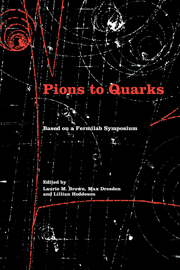Book contents
- Frontmatter
- Contents
- List of contributors
- Foreword by Leon M. Lederman
- Editors' acknowledgments
- Photographs of the symposium
- List of abbreviations
- List of notation
- I Introduction
- II Particle discoveries in cosmic rays
- III High-energy nuclear physics
- IV The new laboratory
- V The strange particles
- VI Weak interactions
- VII Weak interactions and parity nonconservation
- VIII The particle physics community
- IX Theories of hadrons
- 39 The early S-matrix theory and its propagation (1942–1952)
- 40 From field theory to phenomenology: the history of dispersion relations
- 41 Particles as S-matrix poles: hadron democracy
- 42 The general theory of quantized fields in the 1950s
- 43 The classification and structure of hadrons
- 44 Gauge principle, vector-meson dominance, and spontaneous symmetry breaking
- X Personal overviews
- Name index
- Subject index
40 - From field theory to phenomenology: the history of dispersion relations
Published online by Cambridge University Press: 07 May 2010
- Frontmatter
- Contents
- List of contributors
- Foreword by Leon M. Lederman
- Editors' acknowledgments
- Photographs of the symposium
- List of abbreviations
- List of notation
- I Introduction
- II Particle discoveries in cosmic rays
- III High-energy nuclear physics
- IV The new laboratory
- V The strange particles
- VI Weak interactions
- VII Weak interactions and parity nonconservation
- VIII The particle physics community
- IX Theories of hadrons
- 39 The early S-matrix theory and its propagation (1942–1952)
- 40 From field theory to phenomenology: the history of dispersion relations
- 41 Particles as S-matrix poles: hadron democracy
- 42 The general theory of quantized fields in the 1950s
- 43 The classification and structure of hadrons
- 44 Gauge principle, vector-meson dominance, and spontaneous symmetry breaking
- X Personal overviews
- Name index
- Subject index
Summary
Men make their own history, but they do not make it just as they please; they do not make it under circumstances chosen by themselves, but under circumstances directly encountered, given and transmitted from the past. The tradition of all the dead generations weighs like a nightmare on the brain of the living.
The history of strong-interaction theory in the 1950s is one of a continuous struggle to bring the tradition handed down from the dead generations into conformity with contemporary needs. The tradition was quantum field theory (QFT), and the need was to confront the masses of data on strong-interaction processes emerging from the growing number of high-energy particle accelerators. The struggle originated in the observation that the strong interactions were indeed strong: The pion–nucleon coupling constant, for example, could be estimated to be appreciably greater than unity. The perturbative methods developed in the late 1940s for applications of renormalized quantum electrodynamics therefore failed when applied to the strong interaction. As Steven Weinberg put it in his 1977 Notes for a History of Quantum Field Theory, “it was not that there was any difficulty in thinking of renormalizable quantum field theories that might account for the strong interactions – it was just that having thought of such a theory, there was no way to use it to derive reliable quantitative predictions, and to test if it were true.”
Weinberg proceeded from this observation to remark that “the uselessness of the field theory of strong interactions led in the early 1950s to a widespread disenchantment with quantum field theory” that lasted for almost twenty years.
- Type
- Chapter
- Information
- Pions to QuarksParticle Physics in the 1950s, pp. 579 - 599Publisher: Cambridge University PressPrint publication year: 1989
- 1
- Cited by



